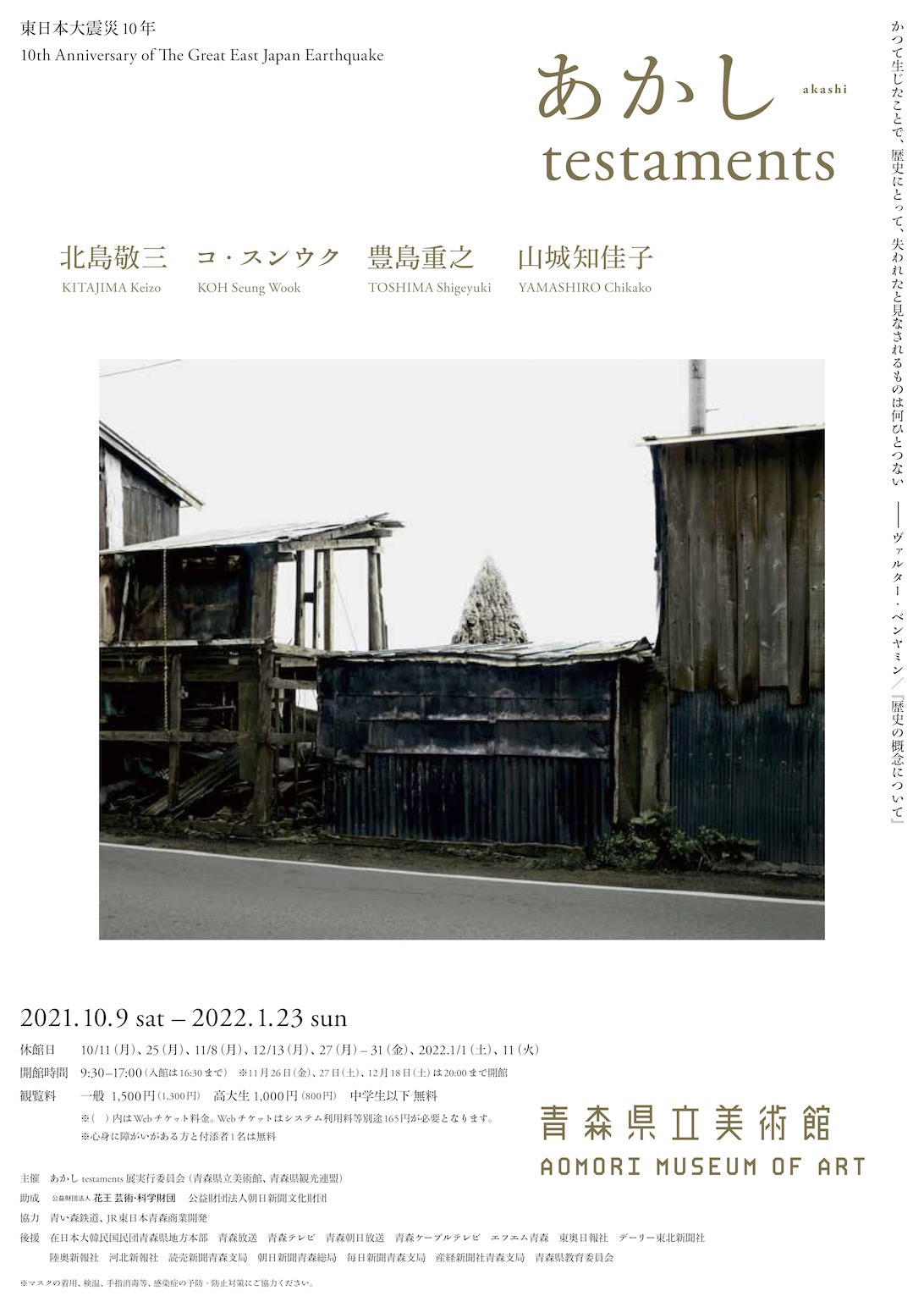AKASHI testaments – 10th Anniversary of the Great East Japan Earthquake
This year marks ten years since the 2011 Great East Japan Earthquake, which inflicted terrible damage and casualties across Tohoku. The Aomori Museum of Art is holding a group exhibition by four artists called AKASHI testaments – 10th Anniversary of the Great East Japan Earthquake. These artists have continuously paid attention to those things that are easily swept away and lost with the changing times, and through their works, we can consider how to pass on the lessons and memories of the earthquake, which are fading with time.
The participating artists are KITAJIMA Keizo, a famous representative Japanese photographer, KOH Seungwook, a Korean artist from Jeju Island active on the frontline of contemporary art, YAMASHIRO Chikako, who is Okinawan and one of the mid-career artists drawing the most attention at the moment, and TOSHIMA Shigeyuki (deceased), a Hachinohe local who displayed his talent in several fields, including theater, art, and criticism. The four artists’ photographs and videos illuminate the exhibition room, shining a light on a world where we can overcome and live alongside disaster within the darkness of forgetfulness and fading memories induced by the passage of time.
![KITAJIMA Keizo, “Sotogahama, Aomori 10 July 2011” [From ‘UNTITLED RECORDS’] ©KITAJIMA KEIZO](https://www.aomori-museum.jp/assets/uploads/2022/02/1652161685-f3ccdd27d2000e3f9255a7e3e2c48800.jpg)
KITAJIMA Keizo, “Sotogahama, Aomori 10 July 2011” [From ‘UNTITLED RECORDS’] ©KITAJIMA KEIZO
Details
Exhibition Name
AKASHI testaments – 10th Anniversary of the Great East Japan Earthquak
Dates
Saturday, October 9, 2021 – Sunday, January 23, 2022
Closed
October 11 (Mon) & 25 (Mon), November 8 (Mon), December 13 (Mon) & 27 (Mon) –31(Fri), January 1 (Sat) & 11 (Tue)
Opening Hours
9:30–17:00 (last entry 16:30) *Open until 20:00 on November 26 (Fri) & 27 (Sat), December 18(Sat)
Venue
The Aomori Museum of Art
Admission
General 1,500 yen (1,300 yen) / High school & college students 1,000 yen (800 yen) / Elementary & middle school students go free
Participating Artists
KITAJIMA Keizo, KOH Seungwook, TOSHIMA Shigeyuki, and YAMASHIRO Chikako
Contact
AKASHI testaments Exhibition Executive Committee
The Aomori Museum of Art, 185 Chikano, Yasuta, Aomori City, 038-0021
Tel: 017-783-3000 Fax: 017-783-5244
Hosts
AKASHI testaments Exhibition Executive Committee (Aomori Museum of Art, Aomori Prefectural Tourism Federation).
Supported by The Kao Federation for Arts and Science and THE ASAHI SHIMBUN FOUNDATION.
Exhibition Structure
Message from the Curators
“Nothing that has ever happened should be regarded as lost for history.”
— Walter Benjamin, ‘Theses on the Philosophy of History’
Ten years have passed since the Great East Japan Earthquake. Since this calamity inflicted terrible damage and casualties a decade ago, in the areas struck by the disaster, social infrastructure has been improved one by one to prepare for future disasters, numerous memorial museums have been built to pass on lessons learnt to the next generation, and events have even been held celebrating ‘recovery’ from the disaster. However, in the process of these developments, we now occasionally witness the voices of people from these disaster-stricken areas being drowned out. Are disasters not, conversely, something that should teach us the importance of listening to these ‘small voices’?
Now that more than half a year has passed since the anniversary, what can we do to save those whose cries have been suppressed as the disaster continues to fade further and further into the past with each moment—so much so that the phrase ‘10th Anniversary of the Great East Japan Earthquake’ reverberates like an opportunity already lost. We invited four artists to this exhibition in order to explore this question: KITAJIMA Keizo, KOH Seungwook, TOSHIMA Shigeyuki, and YAMASHIRO Chikako. They have continually turned their eyes to those things easily lost to the changing times, and the consistency and purity of this attitude makes them a rare breed of artist. When their photographs, films, and installations are displayed in the Aomori Museum of Art, where the heart of the Jomon period still beats, the light born from the interaction of their works will transform into the ‘testaments’ of those ‘small voices’. Standing among those works, we might be able to witness it for a brief moment—the silhouette of that history that never regards anything that has happened as lost.
(Curators: Lee Chong-Hwa, Kuraishi Shino, and Takahashi Shigemi)
Artists
KITAJIMA Keizo (1954-, Nagano Prefecture, based in Tokyo, Photographer)
Active in both Japan and abroad, Kitajima Keizo is a photographer who releases his photographs with deliberate and meaningful timing, exploring the significance of photography as a form of record and the impact photographs can have on people’s visual perception. After attending Moriyama Daido’s photography class ‘Workshop’ in 1975, Kitajima started taking photographs seriously. In his early years, he received critical acclaim for the monochrome snapshots he captured in momentary encounters with people walking on city streets. Since the late 1980s, Kitajima began working on PORTRAITS, a series of portraits taken on a large-format camera, and PLACES, a series of photographs of abandoned and overlooked scenery that he captured while travelling around rural Japan. With PLACES as a predecessor, Kitajima started a new series called UNTITLED RECORDS in 2012, which includes areas struck by the Great East Japan Earthquake as his subjects. He is still taking photographs for this series today. Kitajima has won the Kimura Ihei Award (1983), the Ina Nobuo Award (2007), the Photographic Society of Japan’s Lifetime Achievement Award (2010), and the Higashikawa Prize’s Domestic Photographer Award (2010).
Works on Display: UNTITLED RECORDS, a series of landscape photographs he started taking after the earthquake, and PORTRAITS, a series of portraits where he took fixed-point observational photographs of the subjects.
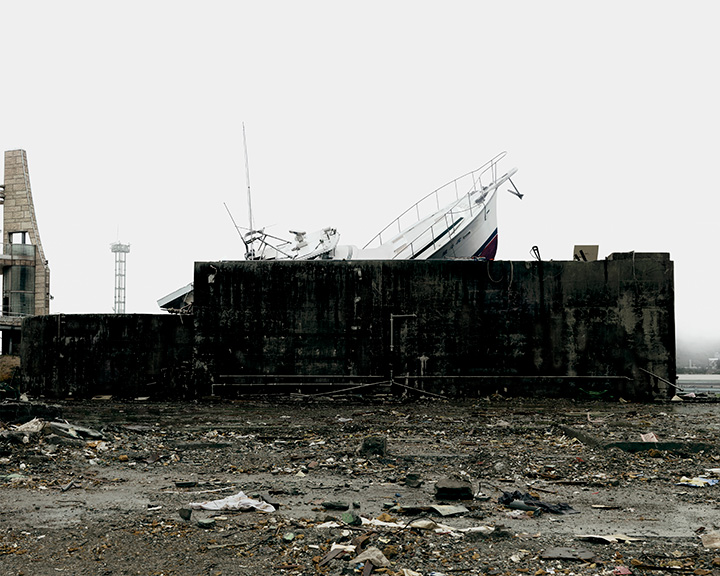
KITAJIMA Keizo, “Ofunato, Iwate 7 Oct. 2011” [From ‘UNTITLED RECORDS’]
©KITAJIMA KEIZO
KOH Seungwook (1968-, Jeju Island, South Korea, Artist)
Koh Seungwook is one of the artists on the front line of South Korea’s contemporary art scene. He studied art at Hongik University (Seoul) and obtained a Bachelor’s degree in fine art. During his early years in Seoul, Koh produced performances and video works that expressed a strong desire to challenge societal norms within a humorous framework while working as the director of Pool (2007-2009), an alternative space that promoted experimental art. In 2012, after returning to his birthplace Jeju Island, Koh created a series of poetic photographs and video works about memories related to historical events on the island that encouraged dialogue with the invisible entity known as the dead. Koh has been chosen to participate in several large-scale international exhibitions, including the Busan Biennale 2006: A Tale of Two Cities: Busan-Seoul / Seoul-Busan and the Jeju Biennale 2017: Tourism. This is Koh Seungwook’s second exhibition in Japan following Art toward the Society: Realism in Korean Art 1945-2005 (The Niigata Bandaijima Art Museum et al., 2007), but this is the first large-scale exhibition featuring his old works in Japan.
Works on Display: Drawings, photographs and new video works, etc., focusing on his video works about the Jeju uprising on Jeju Island after World War Two, in which many of the island’s inhabitants lost their lives.
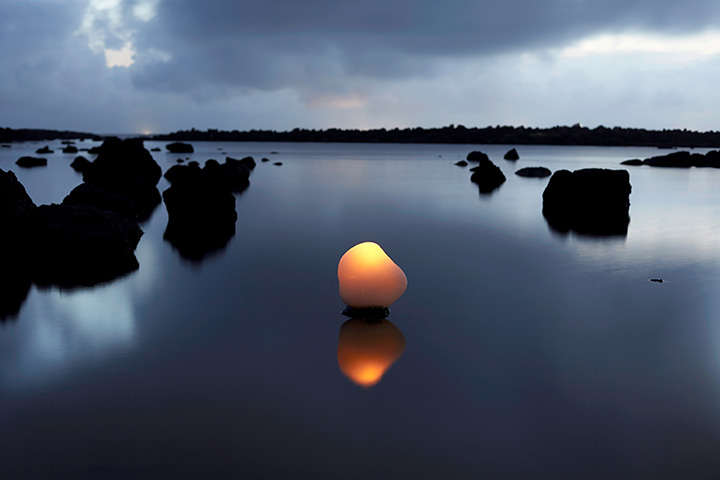
KOH Seungwook, “Stone Candle (Dolcho) 7”, 2010
©KOH Seungwook
TOSHIMA Shigeyuki (1946-2019, Hachinohe City, Aomori Prefecture, Theater Director)
Toshima Shigeyuki displayed his talent in a variety of fields, including theater, art and criticism, while working as a psychiatrist. While Hachinohe remained his base throughout his life, Toshima was active all around the world, producing performances on stages in more than ten foreign countries. From his days as a student at Tohoku University’s School of Medicine, Toshima was active on the avant-garde art scene of the 1960s, collaborating with Itoi Kanji (Dadakan) and others. In 1986, Toshima formed a theater troupe called ‘molecular theatre’. Their radical performances carved out a new horizon for performance art. In 1996, the troupe was officially invited to Australia’s Adelaide Festival, and they won Tokyo Journal’s annual prize for theater in the same year. In 2000, Toshima formed ICANOF, a committee for organizing art projects for Hachinohe residents, and he also was a curator. In January 2019, he passed away at the age of 72. This autumn, a collection of his critical essays will be published in a book titled Ichimokusan (Shoshi Shigosen).
Works on Display: Photographs, sound installations, etc., focusing on the scenography used in Molecular Theatre’s theatrical production Perpendicular / Epicenter (2002).
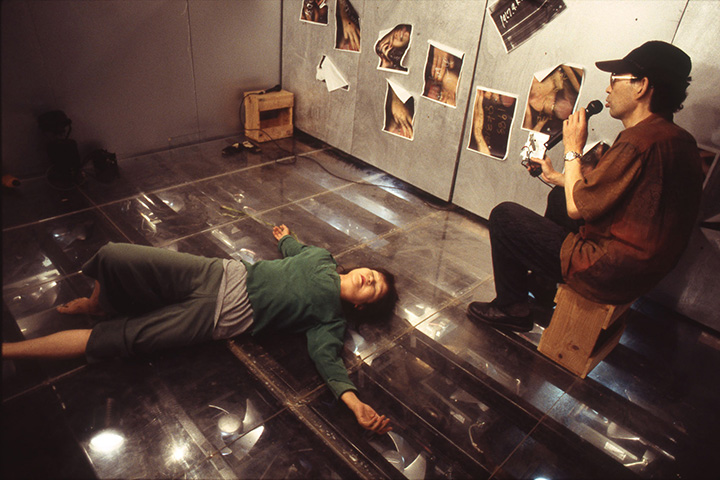
TOSHIMA Shigeyuki, “Legend of Ho” (2000) by molecular theatre
[Photo: YOSHIDA Toru](Left: NAKAJIMA Natsu / Right: TOSHIMA Shigeyuki)
YAMASHIRO Chikako (1976-, Okinawa Prefecture, Filmmaker & Artist)
Yamashiro Chikako is one of the mid-career artists drawing the most attention at the moment. She creates works that feature her birthplace Okinawa as the subject, including films, photographs, and performances. You can follow the development of Yamashiro’s career from her early works that touched on concrete historical and societal matters, such as the Battle of Okinawa and issues surrounding the US military base, to her recent works that effectively incorporate elements of fiction and abstract imagery to convey memories that cannot be expressed verbally. Yamashiro’s works have a sense of universality that surpasses both borders and generations, and they have received critical acclaim both in Japan and abroad. Recently Yamashiro had a large-scale solo exhibition at the Tokyo Photographic Art Museum called Yamashiro Chikako: Reframing the land/mind/body-scape (until October 10). Yamashiro won the Grand Prize at the Asian Art Award 2017 supported by Warehouse TERRADA (2006), the ZONTA Prize at the 64th International Short Film Festival Oberhausen (2018), and the Tokyo Contemporary Art Award, 2020-2022 (2020).
Works on Display: Newly configured video installations and new photographs with a focus on her early masterpiece Your voice came out through my throat, which is about the memories of war.
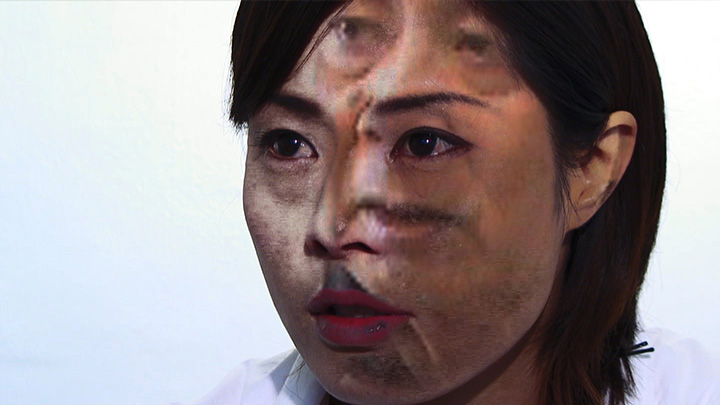
YAMASHIRO Chikako, “Your Voice Came Out Through My Throat”, 2009, Video
©Chikako Yamashiro, Courtesy of Yumiko Chiba Associates
